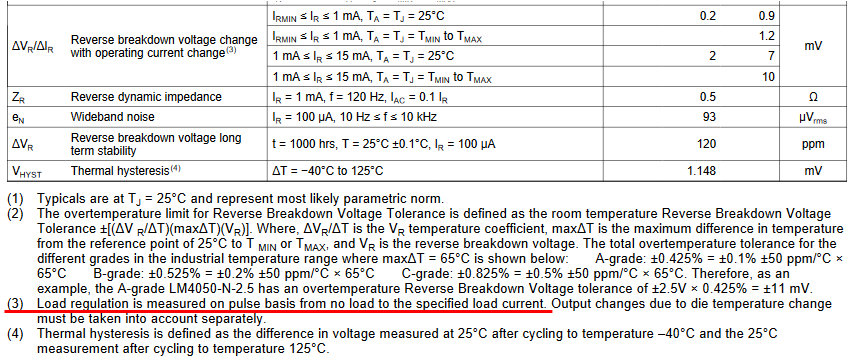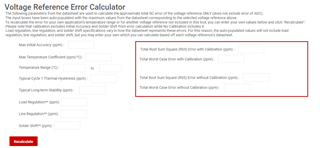May I ask whether the chip can guarantee that its output meets the accuracy of 0.1% at 25℃ under the following conditions?
The chip current in our application is approximately 0.8~0.9 mA. Thanks

This thread has been locked.
If you have a related question, please click the "Ask a related question" button in the top right corner. The newly created question will be automatically linked to this question.
May I ask whether the chip can guarantee that its output meets the accuracy of 0.1% at 25℃ under the following conditions?
The chip current in our application is approximately 0.8~0.9 mA. Thanks

2. What is the actual current accuracy of the stable operation? Does it need to consider "deltaVR/deltaIR?
From the comments below, it only needs to be considered when going from no load to load. Please explain. Thanks!

Hi Mingkang,
As long as you are using an A grade LM4050-N-Q1 under your conditions the output voltage accuracy should initially meet the 0.1% at 25°C. Load and Line regulation do not need to be taken into account so long as the supply voltage to the device as well as the output load that the device is supplying are stable. This means that the output load is not changing, in the datasheet example they represent that change as varying from no load to a specifically set load. The long-term stability of the device will degrade this 0.1% accuracy over time.
Please see the voltage reference error calculator tool for more information on parameters that impact output accuracy and calculating the total error. https://dev.ti.com/gallery/view/LPVRS/ADC-TO-VREF-SELECT_Design_Tool/ver/1.0.0/ 
Thanks,
Joshua
Thanks for your reply, Joshua. Let me make it clearer. The chip current in the application below is about 0.8~0.9mA. What is the output voltage accuracy of VCC-AREF after stabilization? Also meet the 0.1% at 25°C?

Hi Mingkang,
Under a 0.8~0.9mA operating current the device will not meet the 0.1% accuracy, this is only applicable at 100uA operating current. Increasing the operating current will increase the reverse breakdown voltage tolerance. Allow me to get back to you by end of day 2/21 on reverse breakdown voltage tolerance at 0.8~0.9mA operating current.
Thanks,
Joshua
Hi Mingkang,
After clarification with back end team the Reverse breakdown voltage change with operating current change (ΔVR/ΔIR) does need to be taken into account in steady state conditions. The reasoning for describing the load regulation as measured on a pulse basis is not to signify under changing load conditions, but rather to explain that the test was done fast enough to prevent the current from heating the device and therefore, is independent of die temperature change. Numerically taking this into account (not including long-term stability) the Reverse Breakdown Voltage (Max) = base value + tolerance + change with operating current change = 4096 mV + 4.1 mV + 0.9 mV = 4101 mV which is roughly 0.122% accuracy.
Thanks,
Joshua